Professor Tatsuo Suzuki 8th Dan Hanshi (Ph.d)
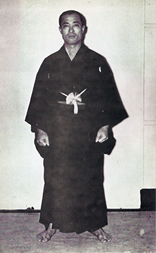 The late Professor Tatsuo Suzuki was born in Yokohama in 1928 and became interested in Karate at the age of 14 and within six years of beginning his study of Karate, Professor Suzuki was awarded his 3rd Dan at the age of 19. In 1951 at the age of 24 he was awarded the then highest grade in Wado-Ryu, 5th Dan for his outstanding courage and ability.
The late Professor Tatsuo Suzuki was born in Yokohama in 1928 and became interested in Karate at the age of 14 and within six years of beginning his study of Karate, Professor Suzuki was awarded his 3rd Dan at the age of 19. In 1951 at the age of 24 he was awarded the then highest grade in Wado-Ryu, 5th Dan for his outstanding courage and ability.
At 45 he was awarded his 8th Dan and also in the same year was given the title of Hanshi (Master) by the International Budo Federation and was presented with a special silver cup by Higashi Kuni no Miya, the uncle of the late Emperor of Japan.
From 1945 to 1956 he received direct instruction from the founder of Wado Ryu, Hironori Ohtsuka Sensei at the Wado Ryu Headquarters. Thereafter, as Ohtsuka Sensei's most senior student, he travelled with Ohtsuka Sensei both domestically and internationally performing demonstrations and teaching at the Headquarters and in such places as Hawaii.
From 1956 to 1964 Master Suzuki founded the first Wado Federation in England and from his base in London he spread Wado Ryu throughout Europe. Overcoming many difficulties, he brought senior students from Japan, taught them how to be instructors and sent them to various European countries. Within just a few years Wado Ryu became the most popular style in Europe. In 1991 Master Suzuki took over from Ohtsuka Sensei in protecting the essence of Wado Ryu and established the Wado International Karate-Do Federation.
 In addition to his accomplishments in Karate, Professor Suzuki is a 2nd Dan in Tenshin Koryu Bo-Jitsu (stick fighting) and a 1st Dan in Judo. He has also studied Zen doctrine with the high priests, the late Genpo Yamamoto and Soyen Nakagawa. Suzuki Sensei is also a member of the International Budo Academy (IBA) as an Associate Professor and was award the title Doctor of Philosophy for his life long work and commitment to teaching Wado Ryu Karate.
In addition to his accomplishments in Karate, Professor Suzuki is a 2nd Dan in Tenshin Koryu Bo-Jitsu (stick fighting) and a 1st Dan in Judo. He has also studied Zen doctrine with the high priests, the late Genpo Yamamoto and Soyen Nakagawa. Suzuki Sensei is also a member of the International Budo Academy (IBA) as an Associate Professor and was award the title Doctor of Philosophy for his life long work and commitment to teaching Wado Ryu Karate.
From 2005 Suzuki Sensei suffered from illness but through a strong mind and drive was back teaching by 2006. Over the next few years Sensei started to restructure his federation to ensure it would continue after him. In 2008 he appointed a World Technical Committee to ensure aligned and consistent standards and the following year at 2009 European Championships Suzuki Sensei stood down as World Chief Instructor appointing Sensei Jon Wicks as his successor to the role.
On the 12th July 2011 our Sensei passed away, Sensei’s life goal had been to protect Wado Ryu as he’d been taught by his teacher Hirinori Ohtsuka; this was the reason he formed the Wado Kokusai Karate-Do Renmei and this is the goal he left us today – to protect those teachings.
Back in 1990 it was a very difficult decision that Sensei took to form his own federation and one that he didn’t take lightly. However a large number of senior students remained loyal and followed Sensei, it was this loyalty that Sensei valued and held core to his beliefs and teachings. So strong was his belief in loyalty that before he died Sensei wrote a letter to all those students that continued to follow him.
Although in his letter there are many points that all students of martial arts can learn from it was written for his current students at that time, the students of the Wado International Karate-Do Federation. Sadly many non-WIKF clubs and associations have used Sensei’s letter aiming to strengthen their lineage, however if you were not member of Sensei’s federation you missed one of his key teachings; to be part of his loyal WIKF family and to put this family first.
To quote the last part of Sensei’s letter: “Through various instructors in the WIKF throughout the world, I have ensured that this will carry on. A strong family that will help each other and the future of Ohtsuka Sensei’s authentic Wado Ryu will carry on".
Also See - Tatsuo Suzuki - My Life
This letter was written by Sensei Tatsuo Suzuki before his passing in 2011, it was his final words for those loyal students of the Wado International Karate-Do Federation that remained by his side during his life and carry on his teachings after his passing by remaining one united WIKF family.
'A Letter from Sensei'
"I want to tell you about when I started Karate and how I trained and how I want you to tell all my karate students. Most students do not understand about what my Karate world is. Anyway this is very simple not only for Karate students but for all life.
When I started Karate I did not want to just learn the techniques but with mind and body and spirit as well. I contacted Ohtsuka Sensei because he was the founder of Wado Ryu and already a great teacher. He heard that I wanted to follow his example completely and became my teacher.
Ohtsuka Sensei was a true Martial Artist he acted in all things as he should as a martial artist not just technically but mentally and physically as well. He was not just a Karate man but a true Martial Artist. In Japan Karate, Kendo Aikido were learnt differently, they were learnt as martial arts. Most people chose only one of these and studied them fully but Ohtsuka Sensei had practiced many martial arts from a small child and he learnt them as a martial artist, mentally physically and technically this is what made him a great martial artist. This is why I wanted to learn from him how to be just like him in all ways. This is why I trained so hard many, many hours each day to be like him in all things and to understand.
When Ohtsuka Sensei passed away I wanted to follow his life and carry on his teachings exactly the same way he had done. Because I had trained so hard with him for so long I understood the way he practiced martial arts. I wanted to have the same attitude as Ohtsuka Sensei and this is how I learnt.
I copied the way Ohtsuka Sensei taught in all things mentally, physically and technically and this is what I passed on, all things not just one of them. Many teachers do not pass on like this as they do not understand. After Ohtsuka Sensei passed away other instructors changed many techniques as they did not understand them, they were not proficient enough as they had not followed Ohtsuka Sensei’s example. I was the only one to follow his way. Others did not follow him in Karate, one because they were not proficient enough and also because they had not had enough training or understanding to follow him in all aspects and so things were changed.
I was very upset and decided that I must carry on Ohtsuka Sensei’s teaching myself because I was in Japan a professional. I always followed Ohtsuka Sensei but unfortunately others could not because they were not professional in all three (mental, physical and technical) they did not understand enough to carry on his way properly. Sensei’s life had been wonderful to me and I wanted to follow his way exactly but now there was no one to teach me and I had to carry on myself.
When I was studying with Ohtsuka Sensei in his old age he could not teach properly and the other instructors did not have enough training to understand. Their technique was therefore not as fully developed and it was impossible for them to teach as they had not learnt all the aspects fully (mental, physical and technical). However I had always learnt the way he practiced Karate and I understood. His way was to show the technique and practice the technique again and again until the body and mind understood to do the technique without thought. He did not teach by talking, he demonstrated not always talking.
When I came to England I taught like Ohtsuka Sensei and demonstrated for students to copy. This is very important, the instructor by show the technique as example not just by talking. In Japan when some people got old they did not demonstrate, they just talked and then the body forgets the proper technique. Ohtsuka Sensei did not teach like this even when he got old and also neither have I. It is a very bad thing. We always practiced together with the students.
This is why, when I came to England I always demonstrated from the beginning and did the techniques together with the students in front of them so they could copy.
I was very surprised when I first came to England, because at that time in Europe Karate was very unknown as the only martial art then known was Judo as a world champion had been English. Lots of people then wanted to know about martial arts. But after a time the Karate was poor because the instructors were not of a sufficiently good standard. The English government wanted to stop Karate because many people were just reading books and watching films like Bruce Lee and did not understand. At that time many newspapers, magazines and journalists came to me and asked why this was. Unfortunately there were no proper Karate groups and most were run by people without sufficient understanding and training. We were the only ones training like Sensei’s way and other people had not trained properly. When teaching in England I taught in exactly the same way I had trained with Ohtsuka Sensei in Japan. Other Karate instructors had not had sufficient training from proficient teachers. It was very hard for me because most people misunderstood Karate and had not learnt properly, but for me there was no problem.
I travelled all over the world teaching by demonstrating in Ohtsuka Sensei’s way. This was important, as I could not communicate by voice in all these countries but by copying the technique and to see the way I trained I could communicate to these entire countries and they could understand the martial art way.
At the same time I was also training very, very hard to keep my technique good in order to demonstrate good technique. I did not want to just remember the technique mentally this is no good. I trained hard by myself in order to keep good technique. I always practiced in front of the students to demonstrate the right way and be on top of them. Many students were training very hard with me and understood that training very hard for a long time together is very important.
I have carried on training and teaching like this for a long time the same way, I never give up. Always on top of them Students tried very, very hard to follow me. I never give up I have to show how I am standing up and how much power. Then students would know proper technique.
All over the world people wanted an International Karate Federation to be formed. I did not want lots of students, only those true martial artists.
In Japan most senior Wado instructors had stopped training but they told me when I started this new federation that they could not follow me but they wanted to help me. Many people are helping me, this is why the federation started. I thought that at the beginning there would not be many students but soon we had many students all over the world.
I have never given up my way of teaching, always teaching and training. If like this I can continue teaching and training for a long time. I never give up training, training and training and teaching. Never talking always demonstrating, the same way I have always taught.
In 1990 I started the WIKF and carried on with the teaching and training in the same way as Ohtsuka Sensei. I taught all the students together and trained with them and we became like a big family helping each other. I like it like this, this is my way and the best way.
Finally in November 2005 I suffered a big heart attack and at that time I could not teach for a while. By 2006 I started teaching again slowly, slowly and during this time I kept training. I became stronger and stronger again that by 2007 and 2008 I could teach around the world again.
In October 2008 I again had problems and many students began to help me. They thought I was a very hard teacher always training hard together with them. I could not teach them any more but they still wanted to train together with me all the time.
After my cancer operation in November 2009 my students still wanted to train with me. Many were calling me and asking when I would be teaching again. I was very surprised because I could no longer teach but students still wanted to train hard with me. I could not travel to other countries but many students travel to London to the various courses that we hold.
Because of this from my students my spirit never gives up. The loyalty has surprised me and this is important as it is very good for my spirit.
I have tried to ensure throughout my lifetime that the true spirit of Ohtsuka Sensei’s Karate is carried on. I have done this for the past 30 years since he passed away and I have also imparted my knowledge and spirit to various instructors to carry out the work and ensure the future of the WIKF and traditional Wado Ryu as it was taught to me by the founder. Through various instructors in the WIKF throughout the world, I have ensured that this will carry on. A strong family that will help each other and the future of Ohtsuka Sensei’s authentic Wado Ryu will carry on."
"My Life" - by Tatsuo Suzuki
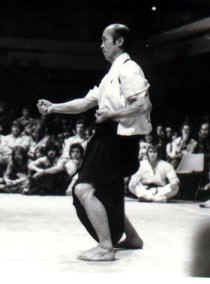 I was born in Yokohama, Japan in 1928. My father was a fun loving man who enjoyed life to the full. He loved to cook, and owned a large restaurant. It was often hired by businessmen and local dignitaries for private parties where they could eat, drink and be entertained by Geisha.
I was born in Yokohama, Japan in 1928. My father was a fun loving man who enjoyed life to the full. He loved to cook, and owned a large restaurant. It was often hired by businessmen and local dignitaries for private parties where they could eat, drink and be entertained by Geisha.
This all came to and end when we were forced to move to the country to avoid American bombers during the war. School life was hard, and senior students would often beat the younger children for no reason. It was very militaristic, we looked upon our teachers as gods, I suppose it was just like the Samurai and his Lord.
I desperately wanted to become a soldier but was too young. I tried to join a naval academy but was rejected due to an eye problem. In hindsight I was actually quite lucky as they were all training to be Kamikaze pilots but at the time I was devastated. I was raised with the Bushido code, to die for my emperor and country would have been a great honour.
It was while at school that I had my first taste of martial arts. We practiced Kendo every day. When I was 14 years old I met one of my school friends older brother. He had studied Wado Ryu Karate while at university; from then on whenever he came home I would ask him to teach me. Eventually he agreed, it was all fighting - nothing technical.
After the war my family moved back to Yokohama. The Americans were occupying Japan and despite my hatred of them I ended up working at one of their army bases as a cleaner. Government propaganda had turned Americans into demons that killed our men and raped our women. Through working at the base I came to realise that this was a lie. At that time food was scarce, we were living off insects and rice. The Americans gave us food, chocolate and of course Coca Cola. I loved it, it was all I ever wanted to drink, now I hate the stuff!
 I decided to learn English and went to the local YMCA where they held classes. Once there I discovered that they also taught Karate. I knew that it was Karate that I wanted to do and soon forgot about learning English. The instructor there was a man called Mr. Kimura. He was one of Professor Ohtsuka's best students. Professor Ohtsuka was the founder of Wado Ryu Karate.
I decided to learn English and went to the local YMCA where they held classes. Once there I discovered that they also taught Karate. I knew that it was Karate that I wanted to do and soon forgot about learning English. The instructor there was a man called Mr. Kimura. He was one of Professor Ohtsuka's best students. Professor Ohtsuka was the founder of Wado Ryu Karate.
The Americans had banned all martial arts so we had to call Karate, Japanese boxing. I trained at the YMCA for about 6 months before we had to move on. We would train wherever we could, in gardens or fields, in the rain and snow, anywhere the American's could not find us. Kimura was a very intelligent man with a very sharp technique. He was a 5th Dan at the time the highest grade in Japan.
I was fascinated by the way of the warrior and the samurai code. I read books on Budo, Bushido and Hagkure. As a boy I dreamt of being a samurai hero. After the war we were not allowed swords, so I looked for a martial art without weapons. In Judo it was always the big guy who won, but Karate was different. With speed, timing and good spirit I could defeat any opponent large or small.
Post-war Japan saw the Japanese people embrace everything American, baseball, coke, Elvis. I wanted to give the world something Japanese. I decided to become a great martial artist so I could teach the world about the Japanese spirit.
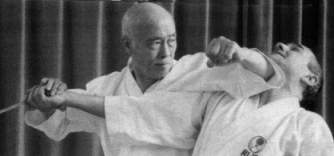 When I first started I was only training four hours a day that eventually increased to 10. Everyone thought I was crazy but I believed that to be the best I had to work longer and harder than anyone else. I would train in a shrine garden near my home until well into the early hours of the morning. By wearing my gi (the white Karate outfit) I inadvertently started a rumour of a ghost who stalked the shrine at night.
When I first started I was only training four hours a day that eventually increased to 10. Everyone thought I was crazy but I believed that to be the best I had to work longer and harder than anyone else. I would train in a shrine garden near my home until well into the early hours of the morning. By wearing my gi (the white Karate outfit) I inadvertently started a rumour of a ghost who stalked the shrine at night.
At the end of every year I would go up to a temple in the mountains for two weeks. There I would train every day from morning until night, only stopping for one small meal. To eat any more would make me sick. My day would start with a run, followed by Zen meditation. After that I would practice my punching by extinguishing a candle flame with just the force of my punch. Next I would work on my kicks by wearing iron boots. This built strength and speed. My favourite technique was the sokuto (side kick), Ohtsuka sensei would tell students, if you wish to practice sokuto go see Mr. Suzuki.
That would be followed by three hours of fighting with my fellow students. By the end we would be physically exhausted. To end the day I would practice kata (set moves against imaginary attackers). I would perform each kata three times. When finished my body would feel great all the days aches and pains gone.
I would travel to Tokyo several times a week to train with Ohtsuka sensei. He was a truly great man. Away from Karate he was a gentleman but inside the dojo he was like a true samurai. He would train with us as well as teach us. Many of his senior black belts had returned from the war, they were tough both physically and mentally. The fighting in those lessons was extremely hard.
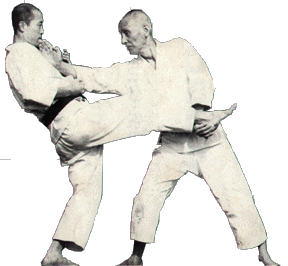 In the old days fighting was different than it is today. There were no rules, any technique was allowed; kicks to the groin, strikes to the eyes or throat. Contests would be organised between the various universities. We would visit with a team of 10 fighters - to us they were the enemy, especially if they practiced a different style. Nowadays most styles fight pretty much the same way, but back then I could tell a person's style of Karate from the way he fought. Shotokan fighters were very stiff and liked lots of room, whereas Goju Ryu liked to get in close - Wado Ryu would be somewhere in between.
In the old days fighting was different than it is today. There were no rules, any technique was allowed; kicks to the groin, strikes to the eyes or throat. Contests would be organised between the various universities. We would visit with a team of 10 fighters - to us they were the enemy, especially if they practiced a different style. Nowadays most styles fight pretty much the same way, but back then I could tell a person's style of Karate from the way he fought. Shotokan fighters were very stiff and liked lots of room, whereas Goju Ryu liked to get in close - Wado Ryu would be somewhere in between.
The home crowd would be crying for blood and would often try to hit us with sticks or whatever they could lay their hands on. The senior students would referee but would rarely stop a fight unless it looked as if one of us was about to be killed. We would end up fighting on blood-soaked floors. No pads or guards were worn, it was all bare fists. Many people lost teeth or broke noses or other bones. Eventually the heads of all the styles got together to devise competition rules. They were concerned that potential students were being put off.
In 1963 I and two other students traveled the world demonstrating Wado Ryu Karate. This resulted in offers from several countries to come and teach. I narrowed it down to either Britain or America, as English was the only other language that I could speak. I was offered a sponsorship deal by some American businessmen, but a leading Shotokan instructor, Ohshima, was already teaching there so I declined.
I moved to England in January 1965. It was hard to settle at first. My English was very basic, I had to take a Japanese/English phrase book to lessons to try to explain my teaching. As I was the only Japanese instructor in England everyone wanted me to teach them. Demands on my time were so great that I had no time to do any other work.
At first I thought that it would be difficult to teach westerners an oriental martial art. Back in Japan I had been told that Westerners could not move as we did because they sat on chairs as opposed to the floor, as a result they had no hip power obviously this was wrong.
I missed Japan, I was living in a bed-sit that would get so cold that it would be impossible to sleep. I would have to train to warm-up before going to bed. There were no Japanese shops and I longed to eat some Japanese food.
 The whole profile of martial arts in the west took a great leap forward during the so-called 'Bruce Lee boom'. I found myself on TV and in the papers all of the time. This kind of attention always attracts people out to prove themselves. None of them were any good. There was once a Hungarian man who claimed to be one of Bruce Lee's top students, after one month's training with him, a student would be able to beat any opponent. I was outraged by this claim so I contacted the paper that ran the article and challenged him to a fight under any rules that he cared to set. I waited but heard nothing, so eventually I rang them back. He had told them that he had already beaten me and saw no reason to fight me again. I laughed, he was obviously scared to face me man-to-man. Over the years I have proved myself and gained people's respect. I still like a good fight though. Most days I spar with Kevin, an instructor at my London dojo, it helps to keep me sharp.
The whole profile of martial arts in the west took a great leap forward during the so-called 'Bruce Lee boom'. I found myself on TV and in the papers all of the time. This kind of attention always attracts people out to prove themselves. None of them were any good. There was once a Hungarian man who claimed to be one of Bruce Lee's top students, after one month's training with him, a student would be able to beat any opponent. I was outraged by this claim so I contacted the paper that ran the article and challenged him to a fight under any rules that he cared to set. I waited but heard nothing, so eventually I rang them back. He had told them that he had already beaten me and saw no reason to fight me again. I laughed, he was obviously scared to face me man-to-man. Over the years I have proved myself and gained people's respect. I still like a good fight though. Most days I spar with Kevin, an instructor at my London dojo, it helps to keep me sharp.
I had several jobs while I lived in Japan, which sometimes required me to use Karate, including nightclub bouncer and bodyguard. There was often friction with the yakuza (Japanese gangsters). I once found myself up against a local yakuza gang. I was alone but there were about 20 of them. I backed up to a wall and picked up a large rock. If I stepped forward they would move back, if I moved back then they would move forward. Luckily one of my friends was passing by on his way to buy some sake and saw what was happening. He run back to our house and returned with help. Even though there were only 5 us of against 20 of them, the yakuza were terrified. One of their gang had recently lost an eye in a fight with a Karate man. I dropped the leader with a blow to the groin and knocked out another one who came at me with a knife. The rest of them eventually managed to run off. I realised that I had lost my university cap - I would be in serious trouble if it were to be found by the police. I searched everywhere for it and eventually found it under the body of a yakuza. The next day I scoured the papers for reports of a dead body but found nothing - I guess no one was seriously hurt.
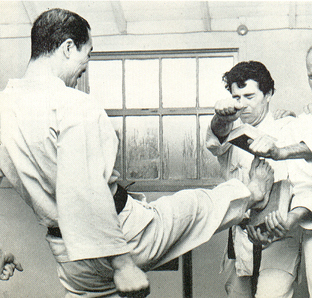 Fear with regards to fighting can be overcome by mental training. It's a vital aspect of Karate training. It is important when fighting to have a strong spirit and a brave heart. When attacked you must never be scared or startled. You must believe in yourself this is difficult to achieve. A famous samurai was once asked what he would do if he were attacked in the street. He replied that he would move towards his attacker so that he could not strike down with his sword. To back off or freeze would mean death. I would often go to monasteries to learn Zen meditation from the monks. A samurai would not fear death before battle, this was the state of mind that I aimed to reach. I am always careful though, and will never change in believing that I am invincible. You must be wise and careful.
Fear with regards to fighting can be overcome by mental training. It's a vital aspect of Karate training. It is important when fighting to have a strong spirit and a brave heart. When attacked you must never be scared or startled. You must believe in yourself this is difficult to achieve. A famous samurai was once asked what he would do if he were attacked in the street. He replied that he would move towards his attacker so that he could not strike down with his sword. To back off or freeze would mean death. I would often go to monasteries to learn Zen meditation from the monks. A samurai would not fear death before battle, this was the state of mind that I aimed to reach. I am always careful though, and will never change in believing that I am invincible. You must be wise and careful.
These days too many people stop training once they pass 2nd or 3rd Dan, they don't realise that belts are not important. Grades mean nothing, all that matters is to train hard. Many people call themselves 10th or even 12th Dan, but most of them are rubbish.
When I was awarded my 5th Dan no university student had ever been graded so high. I did not want this and asked Ohtsuka sensei not to give it to me but he insisted. It was the same for my 8th Dan. Over the years I have been offered 10th Dan but refused it. It would mean nothing to me, the only man worthy of giving me a grade was Ohtsuka sensei and he is dead.
It is still important for me to train regularly. It can be difficult though, demands on my time have increased tremendously over the past few years. As well as my own training I teach twice a week at my London dojo. I am also the head of a very large Karate federation, the Wado International Karate-Do Federation (W.I.K.F), I travel extensively both here and abroad holding courses for my members.
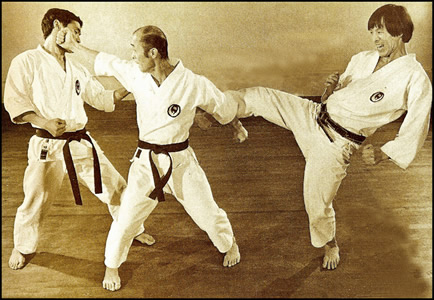 I have sensed a definite shift towards the more traditional aspects of Karate recently. There has been an increased attendance from non-W.I.K.F students at my courses. This pleases me because I feel very strongly that all clubs should have a thorough grounding in the traditional aspects of their style, eve if their bias is towards sport Karate.
I have sensed a definite shift towards the more traditional aspects of Karate recently. There has been an increased attendance from non-W.I.K.F students at my courses. This pleases me because I feel very strongly that all clubs should have a thorough grounding in the traditional aspects of their style, eve if their bias is towards sport Karate.
As a response to this I have re-organised my federation in the UK. Large clubs and organisations can now affiliate with the W.I.K.F and enjoy all the benefits of our courses, competition (both in the UK and abroad) and our guidance, but still keep much of their financial independence. I feel now that it's time for all Wado groups to work closer together whether it be through courses or competition. The fact that we all practice Wado Ryu Karate means that we are all brothers and sisters.
